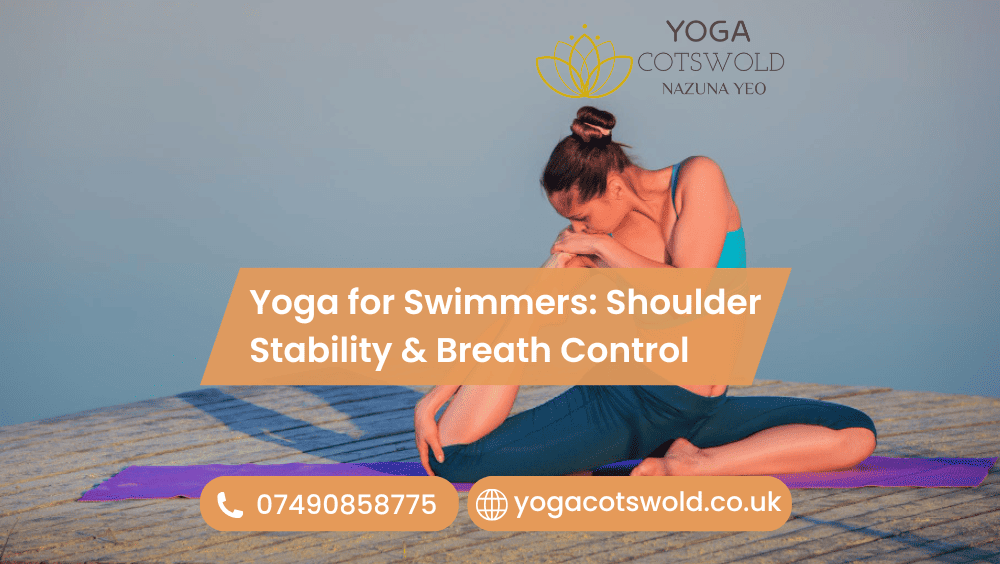Yoga for Swimmers: Shoulder Stability & Breath Control
Yoga for swimmers improves shoulder stability and breath control. Additionally, it enhances flexibility, boosts endurance, and prevents injuries.
HEALTH TIPS
11/17/20256 min read


Apparently,Swimmers live in a world of repetition: stroke after stroke, lap after lap. MoreoverThe rhythm feels glorious, yet tired backs,cranky necks, and tight pecs, can creep in. In addition,With the right mat routine, though, you can keep the engine smooth and the hull streamlined. In this guide, NAZUNA YEO from YOGA COTSWOLD shares a practical programme that builds shoulder stability, improves breath control, and supports efficient, pain-free laps. You won’t need fancy kit; you will need consistency, curiosity, and ten to twenty minutes most days.
Why swimmers need yoga (beyond “just stretching”)
Usually,Pool training builds fitness and feel for the water; even so , it also reinforces overworked lats,shortened pecs, and rounded upper back, . As a result , the rotator cuff struggles to centre the humeral head, and your neck picks up the slack. Moreover Yoga for swimmers counters that cycle from three angles: refines the breath,strengthens the neglected back body, and it opens the front body, so you hold form when fatigue bites. Since you’ll pair mobility with strength, new ranges actually stick rather than vanishing by the next session. Get details on Yoga Teacher in Pittville.
The anatomy of fast, comfortable shoulders
Strong shoulders rely on clever teamwork:
Rotator cuff integrity: on top of that you should try subscapularis,teres minor,infraspinatus, and Supraspinatus, keep the ball centred. Consequently, They prefer steady activation over brute force
Scapular control: The shoulder blade must glide and rotate well. Think lower traps and serratus anterior doing quiet, constant work.
Thoracic mobility: If the mid-back moves, the shoulder needn’t overreach.
Lat and pec balance: Powerful muscles, yes, but they shouldn’t dominate every movement.
Therefore, our plan opens the chest, frees the ribs, and builds fine control around the shoulder blade—without exhausting you for tomorrow’s set.
Pre-pool primer (8–10 minutes)
Use this before main sets. Keep it dynamic and nasal.
3D Rib Breathing (60 secs) — Hands around lower ribs. Inhale wide and back; exhale long. You’ll prime breath control without spiking heart rate.
Cat–Cow with Scapula Slides (60 secs) — Inhale: chest forward; exhale: dome the back. Add a small protraction/retraction to wake serratus anterior.
Thread–Unthread (60 secs/side) — From all fours, reach under, then open wide to ceiling. This boosts thoracic mobility for catch and recovery.
World’s Greatest Lunge (90 secs/side) — Long lunge, twist towards front leg, then sweep arm overhead for hip flexor and lat release.
Dolphin Walks (60 secs) — Forearms down, hips high, tiny heel lifts. You strengthen shoulders in a swim-specific angle. (Keywords: dolphin pose, shoulder stability.)
Plank Tap Drill (60 secs) — High plank, tap opposite shoulder with minimal sway. This grooves scapular control and trunk steadiness for breathing on the move.
Standing Cactus (30 secs x2) — Elbows at 90°, draw shoulder blades down; open the collarbones.
You’ll hit the water taller through the chest and steadier through the core. Looking for a Yoga Teacher in Prestbury?
Post-pool recovery (12–20 minutes)
Now we lengthen what tightens and reset the nervous system.
Supported Fish (2–3 mins) — Place two books lengthways under mid-back and head. Arms wide. Gentle, passive chest opening.
Doorframe Pec Stretch (45 secs/side) — Step through with the same-side foot, keep ribs stacked. Avoid dumping into the lower back.
Child’s Pose to Sphinx (90 secs) — Glide from flexion to gentle extension; breathe into side ribs.
Thread the Needle (60 secs/side) — Free the neck and upper back; release that “post-pull” clamp.
Low Lunge with Side Bend (60–90 secs/side) — Tuck tail lightly; reach the arm up and over for psoas and lat release.
Sleeper Stretch (45 secs/side) — On your side, elbow at shoulder height; rotate the forearm down gently to calm the posterior cuff.
Supine W-Pulls (60 secs) — Elbows by ribs; slide forearms on the floor from W to goalpost. Retrain scapular placement.
Legs up the Wall (3 mins) — Drop the arousal level and flush the calves. Consequently, Finish with three slow breaths.
Additionally your breath should feel unhurried,your neck free,andYour shoulders wide,. Get details on Yoga Teacher in Stow-on-the-Wold.
Strength that sticks (((micro-doses you can keep)))
Swimmers already work hard; we’ll add just enough strength to make mobility useful.
Prone Y–T–W (2 sets of 6 each) — Lift with length, not height. Focus on lower traps, not upper.
Forearm Plank with Reach (((3×20 secs))) keep hips square,alternate, and Slide one arm forward a few centimetres, .
Side Plank Knees-Down (((3×20 secs/side))) you can Drive from elbow to ribs to hips;also imagine long lines from crown to heels.
Band External Rotation (2×12/side) — Light band, elbow by waist. Slow and tidy. (Keyword: rotator cuff.)
Do these two to three times a week, preferably away from your hardest pool days.
Breath control for smoother bilateral breathing
Good breathing isn’t only oxygen; it’s posture and rhythm. Moreover, Try these on dry land, after that translate them to the lane rope.
Diaphragmatic Breathing (2 mins) you can keep One hand on ribs, one on belly. Inhale wide and low; exhale fully. Subsequently,You stabilise the spine without bracing your neck.
Cadence Ladder (((2 mins))) In addition you can Inhale on the count of 4, exhale on the country of 6; after that 4/8. Moreover Longer out-breaths build CO₂ tolerance for relaxed turns and calm the system.
Side-Lying Breath (((1 min/side))) you should Lie on the right, left arm above head; breathe into the left ribs. In addition,Swap sides. Consequently,You prep both flanks for bilateral breathing.
Box Breath Pre-Race (((60 secs))) on top of that you can inhale on the count of four , hold the breath for two , exhale on the count of four , hold breath for two . As a result ,it sharpens focus without drowsiness.
Therefore, you’ll keep stroke length under pressure instead of gasping and shortening the pull. Looking for a Yoga Teacher in Northleach?
Technique cues that transfer straight to the pool
Ribs over pelvis. Stack softly; don’t flare. Streamline improves instantly.
Neck long, jaw soft. Tight jaws drag shoulders forward.
Protract to catch, retract to finish. Let serratus anterior help set the blade; avoid shrugging.
Breathe around the body. Rotate with the torso; keep the crown forward rather than craning.
These cues turn mat awareness into metres per stroke.
A realistic weekly template
Mon: Pre-pool primer (10 min) + light band work (5 min).
Tue: Post-pool recovery (15 min).
Wed: Strength micro-dose (12–15 min).
Thu: Pre-pool primer (8 min).
Fri: Post-pool recovery (12–20 min).
Weekend: you can join a class at YOGA COTSWOLD or One longer combined session (((30–35 min)))
Additionally,Consistency beats intensity. Small, daily nudges keep shoulders happy while metres accumulate. Get details on Yoga Teacher in Moreton-in-Marsh.
Injury-safe modifications (use them proudly)
Sensitive wrists: Swap high plank for forearms; keep dolphin pose short and sweet.
Grumbly shoulders: Reduce range in goalpost/cactus; prioritise sleeper stretch and external rotation work.
Stiff thoracic spine: Add a rolled towel along the spine for supported fish; keep holds gentle.
Neck irritation: Avoid deep backbends; lengthen the back of the skull in all poses.
Modifications aren’t “less than”; they’re how you train today so you can train tomorrow.
Common mistakes swimmers make on the mat
Chasing depth over control. Long lunges without rib control only compress the lower back.
Shrugging through everything. Upper traps love to take over; think “shoulders down, collarbones wide”.
Skipping strength. Mobility fades unless back-body muscles switch on.
Holding the breath. Strain isn’t training. Slow down and let form return.
Spot these early; your shoulders will thank you by the back half of every set. Looking for a Yoga Teacher in Andoversford?
Progress markers you’ll notice within three weeks
Easier head turns and calmer bilateral breathing on tempo sets.
Less ache around the front of the shoulder post-session.
More reach in the catch without neck pinch.
Softer, steadier posture at your desk, not just in the pool.
Small signals, big trajectory.
Related Articles:
» Yoga Teacher in Swindon Village
» Yoga Teacher in Upper Slaughter
» Corporate Yoga Trainer for Companies in Cheltenham
» Group Yoga Classes in Cheltenham
Final word from NAZUNA YEO
Water loves length, ease, and rhythm. Your shoulders do as well. Moreover,With a few steady minutes on the mat, you can breathe like you mean it, steady the blades, and you can open the chest, ,lap after lap. Therefore,If you’d like guidance, join me at YOGA COTSWOLD for a swimmer-friendly class; we’ll customize yoga for swimmers so your training feels sustainable,smooth, and strong, all season.
FAQs — Yoga for Swimmers: Shoulder Stabili& Breath Control
1) Will yoga make my shoulders too loose for powerful pulls?
No—provided you pair mobility with strength. We open the chest and lats, then train shoulder stability with plank variations, dolphin pose, and banded rotator cuff work. Range plus control equals power.
2) How often should I practise around pool sessions?
Aim for two short pre-pool primers and two post-pool recoveries weekly, plus one 12–15 minute strength snack. Keep the longer session for an easier training day.
3) I get neck pain when I breathe to one side. What helps most?
Free the thoracic mobility first (thread the needle, supported fish), soften the jaw, and practise side-lying breath for the non-dominant side. Then cue “eyes down, crown forward” in the water to avoid craning.
4) My shoulders fatigue in dolphin pose. Should I skip it?
Shorten the hold and bend the knees. Build gradually with dolphin walks and forearm planks. You’ll strengthen serratus anterior and lower traps without flaring ribs.
5) Can beginners follow this plan?
Absolutely. Start with the post-pool sequence and the gentler strength set. Use all injury-safe modifications and keep breath smooth. As control improves, add the pre-pool primer.
Contact
info@yogacotswold.co.uk
Social Media
Get in Touch
07490858775








Address: GEORGE MOORE COMMUNITY CENTRE- BOURTON ON THE WATER
Moore Road, Bourton on the Water GL54 2AZ
